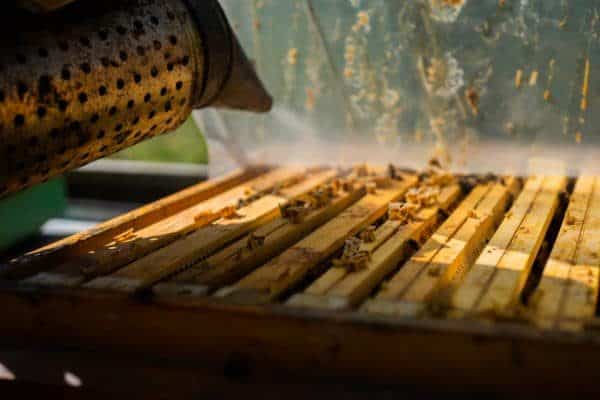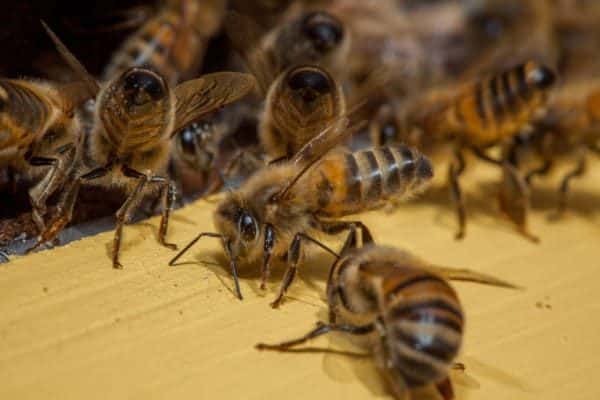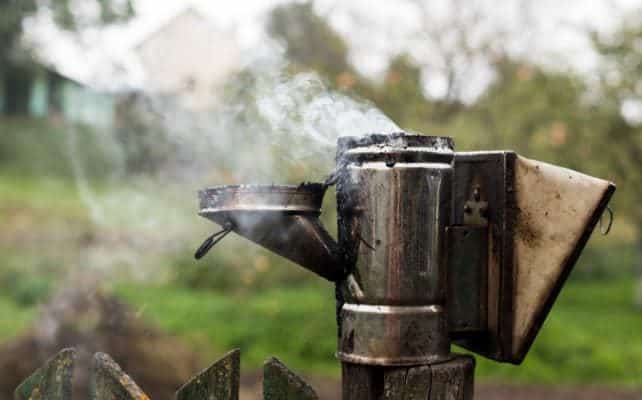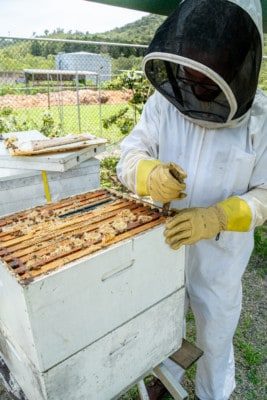Mankind has been using smoke in honey gathering activities and beekeeping for thousands of years. Before the advent of modern beekeeping equipment and methods, beekeepers recognized the importance of smoke in soothing irritated honey bees.

Beekeepers use smoke as it masks the alarm pheromone that is released by honey bees to alert the hive of threat. The smoke interrupts the bee’s communication line allowing the beekeeper to work on the hive more freely. Smoking also triggers an emergency response in bees where they gorge themselves on honey in case they have to abandon the hive. Bees full of honey tend to be calmer.
Now let’s dig a little deeper into how smoke disrupts bee communication and what happens when responsiveness slows down.
What Happens When Honey Bees Are Alarmed?
Honey bees become alarmed when they sense a threat to the hive. When this happens they emit strong smelling pheromones, called Isopentyl acetate and 2-heptanone. A pheromone is a substance secreted by an animal that causes a specific reaction in another individual of the same species.
The effect of these compounds stimulates an alarm response in other bees, which in turn produce similar pheromones so that shortly all the bees are in a state of alarm and ready to attack any intruder that appears to be a threat.
Two different kinds of worker bees are responsible for the defensive behavior: the guards and defenders.
Guard bees are responsible for patrolling the entrance of the hive to deter insects, animals, bees, or any other object or creatures that approach the hive.
When behaving defensively, the “bouncers” appear at the hive entrance. They raise their abdomen and expose their sting chamber to release alarm pheromones; at the same time, they fan their wings to spread the volatile compounds through dispersion.

Other worker bees respond to a danger or a disturbance by flying out and stinging Intruders. As they sting there is more alarm pheromone released marking the threat as a target for other bees. This is why if a beekeeper gets stung you may see them smoke the area of the sting.
Bees will often pursue intruders following the alarm pheromone until the threat is well away from their hive.
The volatile pheromones are highly soluble in the air and can communicate information rapidly to large groups of bees. They are often released when a mass response is required and have an odor similar to ripe bananas.
The component Isopentyl acetate is found in the sting apparatus and 2-heptanone is found in the Mandibular gland. Both substances trigger defensive behavior at the hive entrance. So if you approach a beehive from the front or disturb the bees by creating a commotion near the hive, the bees will raise an alarm in readiness to defend themselves.
How Does Smoke Affect Honey Bees Alarm Pheromones?
By smoking the bees, their sense of smell is disrupted, and are no longer able to detect low concentrations of pheromones through their antennae. (Bees detect smells through their antennae.)
Smoke masks alarm pheromones resulting in a disruption of the bee’s communication. The effect of smoke is reversible and goes away after the smoke dissipates. Gradually, after 10 to 20 minutes, a normal sense of smell then returns to the bees.
Smoke also initiates a feeding response as part of the bee’s fire drill. The bees gorge on honey in anticipation of possible hive abandonment due to fire.
When bees are full of honey, they become lethargic and don’t have much fight in them, and they tend to be much calmer and are easier to work with.
The Bee Smoker And How It Works
A bee smoker is an indispensable device in a beekeepers toolbox and is used by beekeepers to calm bees. Its devised to generate smoke from smoldering materials used as fuel. Moses Quinby (1810 -1875) is credited with this invention and he is also known as the Father of Commercial Beekeeping in America.
Most modern bee smokers have three main components:
- A chamber for holding smoldering fuel material
- A nozzle at the top (also serves as the lid) for directing the smoke
- A bellows for pumping fresh air into the chamber and blowing smoke out of the nozzle

In a smoker the fuel smolders slowly because there is only a small amount of oxygen inside, until a squeeze of the bellows provides a blast of fresh air. This allows the fuel to be used more sparingly than in an open pan. One load of fuel may last many hours.
We have a complete article on types of fuel for smokers, if you are interested. It’s called, “Bee Smoker Fuel: You Have Options”.
The smoke should not be piping hot when using the smoke to calm the bees. So, ensure your smoker is not shooting flames out of the end since this can adversely affect your bees.
How Do You Start A Bee Smoker?
Let’s now look at some of the fuel materials that can be used to start and keep a bee smoker going in order to produce a cool smoke.
Fuel material can include any of the following;
- hessian fabric ((burlap)
- pine needles
- corrugated cardboard
- paper cartons
- rotten wood
- dried cow dung
- herbs
Commercial fuels are also available from some beekeeping supply sources; such as pulped paper and compressed cotton. Experienced beekeepers have a preferred material or mix of materials that works for them. Smoke from pellets of dried female hop flowers (Humulus lupulus) is particularly effective. This is because it contains the sedative lupulin, as experiments have shown.
To get a smoker started, you need matches or a lighter, newspaper or other non-toxic flammable material and smoker fuel. Avoid plastics, treated wood or oily rags as this can produce toxic smoke that you don’t want to be breathing or using on your bees.
Steps to lighting a smoker
Step 1
Flip open the lid of your smoker and shake out any debris. Then insert some of the flammable starter material into the base of the fire chamber.
Step 2
Place a small amount of starter material into the bottom of the chamber and light it. Once the starter material is burning well, place a small amount of your smoker fuel on top.
Step 3
As you gradually add the fuel, steadily pump the bellows to provide oxygen and keep the fire going.
Step 4
To avoid a large flare-up, add fuel at a gradual pace. In this process, the smoker may get very hot so be careful not to get burnt by the fuel chamber.
If you are interested we delve deeper into this in another article called, “Step By Step Guide To Lighting And Maintaining A Bee Smoker”.
Modern smokers have shields that protect you from nasty burns. The shield also allows you to set a hot smoker down without burning the surface on which you place it.
A good idea is to attach a wire hook to hold the smoker or hold it by the bellows. Once fuel begins to smolder, continue to pump the bellows as you add more fuel on top.
With a nice coal base established, pack more fuel on top that will last while you are out in the apiary. This should provide a cool and long lasting smoke that does not die out while you are in the middle of inspecting your hives. To get the smoker to produce lots of cool smoke, the idea is to ensure the fuel burns badly.
The burning fuel in your smoker will create creosote no matter the type of fuel your burn. Creosote buildup in your smoker can make it quite hard to get the lid off. If this happens, heat up the lid using a propane torch and it will come off easily. If you open your smoker while it’s still hot after using it, you can opt to leave the lid loosely on. This way it will not get stuck.
How Do You Smoke A Bee Hive?
There are a few basic steps that a beekeeper follows when smoking bees.
Approach the hive from behind or the side and blast a few puffs at the front entrance. Raise the back of the outer cover while standing at the back of the hive and puff some smoke there.
Then wait for 20 to 30 seconds before removing the cover. Puff once more at the hole in the inner cover and then remove.
Observe the bees on the top bars. What are they doing now? If they don’t appear to be calming down, give them a few more puffs across the top bars.
Try not to over smoke the bees as this tends to make them more defensive and will unnecessarily disturb your hive even more. Over smoking may also give the honey a smoky taste or odor. Having said that though, some hives need a bit more smoke than others.
Here’s something from left field that you might find interesting if you have a wasp problem, Would a Bee Smoker Work on Wasps?
Why Some Hives Need More Smoke Than Others
Different varieties of bees have different temperaments and characteristics. While some are quite laid back and easy to work with, others are fairly defensive.
Examples of peaceful honey bees include Italian, Carniolan, Saskatraz and Russian bees. Some types of Africanized honey bees found in central and south America tend to be more defensive than the native bees.
These bees have spread as far afield as Tennessee, Utah and northern California over the past 7 decades. It’s important to note that not all Africanized beehives are typically hyper-defensive, and under normal circumstances they don’t go around looking for people to sting.
But they react faster and in greater numbers than European honey bees to disturbances and can chase a person for a distance of up to 400 meters. Therefore, it makes sense that they would require a higher dose of smoke to calm them than the more gentle types.
Depending on the honey bees temperament and characteristics, their defensive reactions and intensity will vary. In East Africa, there are about 4 dominant bee varieties found in different environments;
- Apis mellifera scuttellata is found in Savannah grasslands
- Apis mellifera Yementinica (Nubica) occupies Northern dry lands
- Apis mellifera littorea is common in Coastal low lands
- Apis mellifera monticola is more dominant in the highlands and mountain regions
These honey bees are all aggressive and defensive in varying degrees, with the highlands species being the least aggressive of them. M.Scuttellata is extremely defensive.
When working the hives, which more often than not have a mix of different species in the same apiary, it is apparent which hives need more smoke from the hyper-defensive reaction of the bees.
And they do chase a person for a considerable distance of up to 500 meters. For this reason most beekeepers prefer working the hives under the cover of darkness.
The other factor is when you are inspecting a hive packed with honey, the bees may react more aggressively, especially if the colony has a very robust population of worker bees at the peak of the honey flow season. You may need to use more smoke on the hive to effectively disrupt communication between them, thus rendering them more docile.
Typically, honey bees are less active and defensive when temperatures are low like at the onset of winter. Honey bees don’t fly at temperatures below 55°F. When a beekeeper does a hive inspection in these conditions, just a little smoking may be needed.
Beekeepers’ Protective Equipment and Gear
Whenever you are dealing with bees, it is advisable to have the right protective equipment because bees can be dangerous. Wear a long-sleeved shirt and pants and be sure to tuck them in. You can also wear a cap under the bee suit. For footwear, choose gumboots or boots that go way above your ankles.

Most important is a good quality bee suit that needs to be worn correctly. Bees can find small openings and spaces to get at you if the bee suit is not worn properly.
Gloves are also necessary and need to be flexible enough to allow you to hold and work other tools such as the hive tools. Eyewear is necessary for the protection of your eyes. Beekeepers also use a bee veil when around beehives. This protects the face and upper body only.
With experience and an understanding of the temperament of their hives some beekeepers may choose to wear less protective gear. However, if you have an allergic reaction to bee stings you should always wear protective gear.
We have looked into how smoke from a smoker affects bees, but can a bee smoker be used to smoke wasps?
A smoker can be used to smoke wasps but it affects them differently because the smoke actually suffocates them.
The Wrap Up
The use of smoke in beekeeping has been used all through mankind’s interactions with bees. The beginning of commercial beekeeping in America and the invention of the smoker made the process of smoking bees more efficient.
The research done on bee pheromones and how they work has helped beekeepers all around the world to work better with bees and to manage their hives more efficiently and profitably. Hopefully, this most amazing and hardworking insect will continue to thrive in these constantly changing ecological times.
References
https://en.wikipedia.org/wiki/Moses_Quinby
https://en.wikipedia.org/wiki/Bee_smoker
https://entomologytoday.org/2018/09/10/why-smoking-soothes-the-stressed-out-bee-hive/
